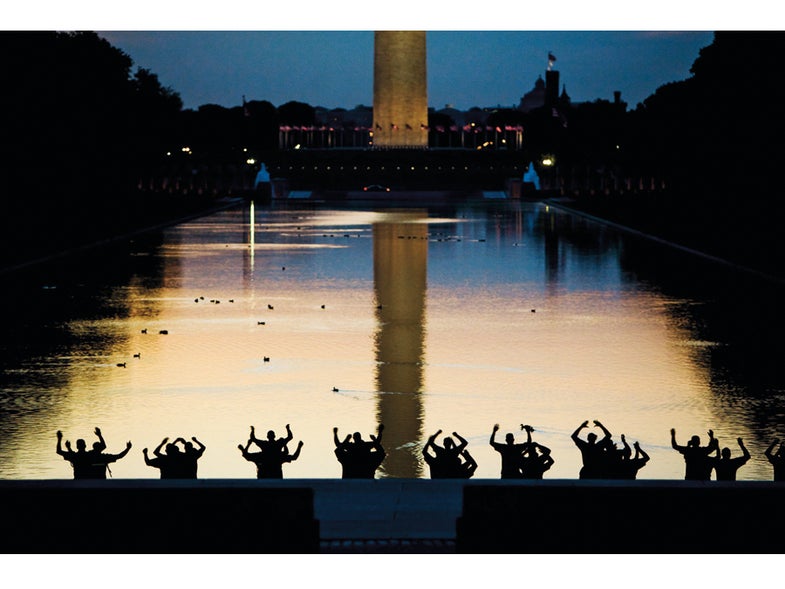7 Tips From A Pro Photojournalist
Being in the right place at the right time isn't the only way to get a great photo.

Photography is like a muscle that needs plenty of exercise. Slack off, and your creativity may fail you.
Washington, DC-based editorial photographer Stephen Voss (www.stephenvoss.com) learned this by heart early in his career. Dragging himself out of bed at 5 a.m. each day during a workshop he was taking with the nature photographer John Shaw, he mentally (and with a silent grumble) repeated his teacher’s mantra: “Don’t be late for work.”
He has never forgotten that lesson. “People think they can walk out at 2 in the afternoon and get a great shot.” You can’t, Voss insists. “You have to leave while it’s dark and be ready when the light arrives. You need to be at the right place at the right time.”
Sure, that’s work, but “the potential for payoff gets me motivated.”
With that combination of discipline and inspiration, Voss went to the National Mall well before sunrise one morning to work on a self-assignment. He uses personal projects to stay sharp and challenge himself to see things with fresh eyes.
This time out, he decided to wait at the Lincoln Memorial to see if predawn sidelight would illuminate the face of the famous portrait statue.
He was scouting the location when he turned to see a platoon of Marines coming up one side of the reflecting pool. As they began their exercises, Voss sprang into action, too.
Here’s his advice for capturing an unexpected scene like this on the fly:
1. Study The Masters.
Voss draws on the lessons he’s learned from poring over the work of master photojournalists such as Eugene Richards and Paolo Pellegrin. “I often spend 30 minutes looking at a great photo, figuring out where the photographer was, how the light was, what lens was used,” he says. “This creates visual memories that come out in the photos you make.”
2. Zoom With Your Feet.
Back at the Mall, Voss sensed he was out of position when the Marines appeared. Seeing the size of the men against the pool, he realized that his high angle would capture too much of the pool relative to the Washington Monument in the background. He needed a lower angle to include enough of the obelisk to make it recognizable-the photo would be much stronger with the sense of place a landmark provides.
So he ran down the steps of the Lincoln Memorial to a lower platform. There he found the angle that properly balanced the silhouetted figures with the monument in the distance and its reflection in the pool.
3. Narrow And Compress.
Telephoto lenses bring things closer and crop the field of view. With a 70-200mm f/2.8L Canon EF IS lens on his Canon EOS 5D, Voss zoomed to compose and saw that a looser crop balanced the visual elements best.
Long teles also compress the apparent distance between the foreground and background. Here, this effect enlarged the men while bringing them closer to their surroundings. This created a more proportionate composition, and at the same time strengthened its narrative and emotional impact.
4. Meter For Exposure, But Shoot In Manual.
Voss was concerned that if the highlights got blown out, the ruffled texture of the water would be lost. To ensure proper exposure, he shot in manual mode and used his Canon 5D’s spotmeter on the brightest part of the scene.
He generally uses the center point for both metering and autofocus, then recomposes his frame for the image he wants.
“I’m always on spotmeter-I’m looking for something where I know what the exposure should be,” he says. “Often, that means skin tones, and whether the subject has a lighter or darker complexion. For example, with light skin you open up 1 to 1½ stops” because the meter gives you a reading for middle gray.
For this photo, Voss set exposure to 1/100 sec at f/2.8, ISO 800. That’s 2 stops (that is, +2 EV) brighter than his meter reading, ensuring that the rest of the scene would be exposed correctly, with just enough detail in the highlights. “You learn how much to compensate by experience,” he says. “With digital you can check it before you move on.”
He didn’t have long to check his exposure this time, though: Voss managed to fire off just three frames before the Marines moved on, too.
5. Always Shoot In RAW.
That’s what Voss does to gain more latitude for tweaking the exposure when he processes his images later on-just in case he got it wrong while shooting.
6. Be flexible.
Looking at his final frame, “initially I wasn’t crazy about how the men overlapped, but afterward I really liked it,” Voss says. “I’ve learned that a little mess, a little uncertainty, or some unanswered questions are a good thing. They make a photo more intriguing.”
That’s an argument for not deleting images when you first look at them.
In editing this photo, Voss punched up the orange, pink and blue a little, but otherwise he left it as he shot it.
7. Stay In Shape.
This begins with your eye-and your brain. “You have to see things clearly,” Voss says. “I’ve only gotten anywhere through hard work and a lot of failures-learning the subtleties within light, looking at photographs and figuring out why you like them. Being observant, being open to what’s going on around you. Understanding the way light hits things and, more importantly, how your camera sees things. It’s an ongoing process.”